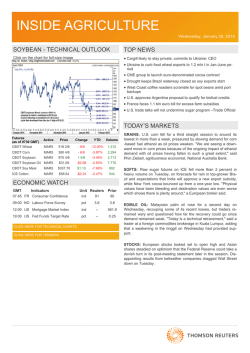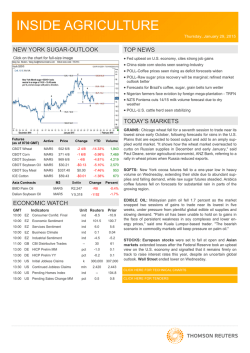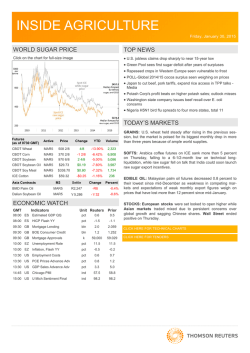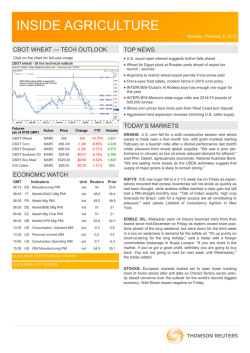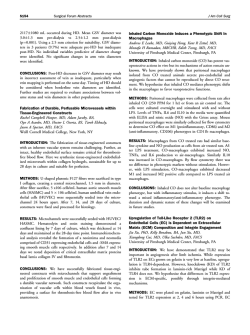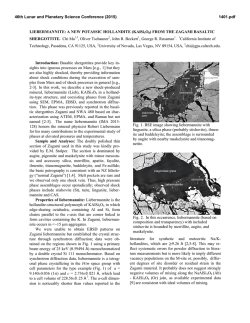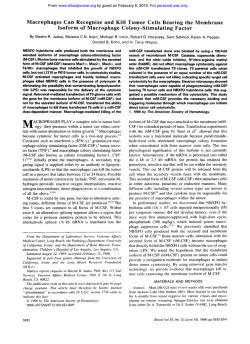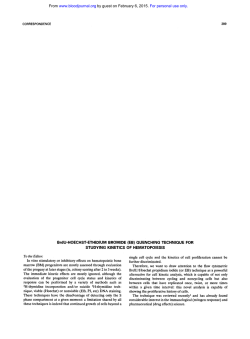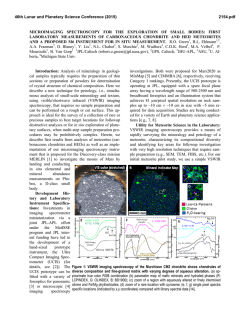
Regulated Expression of CD36 During Monocyte-to
From www.bloodjournal.org by guest on February 6, 2015. For personal use only. Regulated Expression of CD36 During Monocyte-to-Macrophage Differentiation: Potential Role of CD36 in Foam Cell Formation By Ho Young Huh, S. Frieda Pearce, Lewis M. Yesner, Joseph L. Schindler, and Roy L. Silverstein CD36 is an 88-kD integral membrane glycoprotein expressed on monocytes, platelets, and certain microvascular endothelium serving distinct cellular functions both as an adhesive receptor for thrombospondin, collagen, and Plasmodiumfalciparuminfected erythrocytes, and as a scavenger receptor for oxidized low-density lipoprotein and apoptotic neutrophils. In this study, we examined the expression of CD36 during in vitro differentiation of peripheral blood monocytes into culture-derived macrophages. Steady-state mRNA levels of CD36 showed a transient eightfold increase during monocyte-to-macrophage differentiation, peaking at the early macrophage stage (days 3 or 4 in culture), following a gradual decrease back t o baseline levels by the mature macrophage stage (days 7 or 8 in culture). lmmunoblotting with monoclonal antibodies t o CD36 supported this transient, yet significant (8- t o 10-fold) increase in total protein levels of CD36. The increasedCD36 protein was observed at the plasma membrane, whereas an intracellular pool of CD36 was also detected from day 2 t o day 6 in culture through indirect immunofluorescence. A concomitant twofold increase in the cells‘ a b i i i i t o bind ’%thrombospondin at the early macrophage stage (day 4) verified the functional competency of the plasma membrane localized CD36, and supported the presence of an intracellular pool of CD36. The in vitro differentiated macrophages as well as alveolar macrophages remained responsivet o macrophage colony-stimulating factor (M-CSF), a known transcriptional regulator of monocyte CD36. The MGSF-induced macrophages resulted in enhanced foam cell formation, which was inhibitable with monoclonal antibodies t o CD36. Thus, the transient expression of CD36 during monocyte-to-macrophage dfferentiation, and the ability of M-CSF t o maintain macrophageCD36 at elevated levels, may serve as a critical processin dictating the functional activity of CD36 during inflammatory responses and atherogenesis. 0 1996 by The American Society of Hematology. D plasma membrane receptors critical for monocyte/macrophage function such as FcyR, transferrin receptor, type I macrophage scavenger receptors, and the mannose receptor all increase in expression during the monocyte-to-macrophage transition.*-” CD36 is an 88-kD transmembrane glycoprotein expressed on monocytes, platelets, and microvascular endothelium. It functions as an adhesive receptor for thrombospondin-1 (TSP1)i2,’3and ~ o l l a g e n , and ’ ~ mediates cytoadherence of Plasmodium falciparum-infected erythrocytes to the endothe1i~m.I~ The CD36-TSP1 interaction participates in platelet-tumor cell adhe~ion,’~ and macrophage uptake of aged ne~trophils.’~.’’ Furthermore, CD36 has also been shown to function as a scavenger receptor on macrophages for oxidized low-density l i p o p r ~ t e i n , ’suggestive ~ * ~ ~ of a critical role in macrophage foam cell formation and atherogenesis. Regulation of CD36 expression and function as a cellular receptor is complex. We have shown that monocyte adhesion to tumor necrosis factor (TNF)-activated endothelium increases expression of CD36 on the monocyte cell surface.2” This adhesion-induced phenomenon appears to be occurring at the transcriptional level mediated through E-selectin signaling.” Furthermore, soluble mediators macrophage colony-stimulating factor (M-CSF), phorbol myristate acetate (PMA), and interleukin-4 (E-4) enhance steady-state mRNA and protein levels of CD36, whereas lipopolysaccharide (LPS) and dexamethasone decrease monocyte CD36.” Substrate specificity of CD36 has been proposed to be regulated in part by posttranslational phosphorylation and dephosphorylation of extracytoplasmic ser/thr residues on CD36, allowing preferential TSP and collagen binding.” Earlier studies of monocyte CD36 and TSPl expression have dealt mainly with leukemic cell lines. For example, during in vitro differentiation of HL-60 cells to a “macrophagelike” phenotype, TSPl synthesis was suppressed, whereas a 10-fold increase in TSPl receptor expression was seemz3However, the identity of this receptor was not addressed. A 10-fold increase in OKM5 antigen, CD36, during PMA-induced monocytic U937 differentiation has also been IFFERENTIATION OF human peripheral blood monocytes in vitro has been used extensively as a model system for investigating macrophage development. Early morphological descriptions of in vitro monocyte differentiation into culture-derived macrophages and multinucleated giant cells’.’ have been augmented in recent years with increasing cellular and molecular evidence of correlative alterations in enzymatic activity, secretion of soluble mediators, and antigen expression. Morphologically, the first few days in culture are characterized by gradual spreading and flattening, coupled with membrane ruffling and extensions as the cytoplasm-to-nucleus ratio enhances, typifying a macrophage-like From day 7, the multinucleated giant cell population increases steadily and becomes the most prevalent cell type by day 20.’ During the first week in culture, as the monocytes acquire macrophage-like morphology, enzymes such as acid phosphatase, B-glucosaminidase, and macrophage tissue transglutaminase (MTG) have been shown to increase in their relative activity, whereas lysosomal peroxidase exhibits suppressed a~tivity.4.~~’ Moreover, From the Program in Cell Biology and Genetics, and the Department of Medicine, the Division of Hematology/Oncology, and the National Institutes of Health Specialized Center of Research in Thrombosis, Comell University Medical College, New York, NY. Submitted May 18, 1995; accepted October 12, 1995. The first two authors contributed equally to this work. Supported in part by Grants No. NIH-HL 42540, HL I8828 (National Institutes of Health [NIW Specialized Center of Research in Thrombosis), and HL 46403 (NIH Program Project in Vascular Cell Signalling) to R.L.S. Address reprint requests to Roy L. Silverstein, MD. Division of Hematology-Oncology, Comell University Medical College, 1300 York Ave. New York, NY 10021. The publication costs of this article were defrayed in part by page charge payment. This article must therefore be hereby marked “advertisement” in accordance with 18 U.S.C. section 1734 solely to indicate this fact. 0 I996 by The American Society of Hematology. 0006-497I/96/8705-0$3.00/0 2020 Blood, Vol 87, No 5 (March 1). 1996: pp 2020-2028 From www.bloodjournal.org by guest on February 6, 2015. For personal use only. MACROPHAGE CD36: ROLE IN FOAM CELL FORMATION 202 1 with PBS and fresh medium added to adherent cells. The cultured reported.” TSPl expression by human monocytes has been reported to decrease concomitant with cellular a c t i v a t i ~ n . ~ ~ cells . ~ ~ were then incubated at 37°C in a humidified 5% CO2 environment for periods of up to 20 days. Monocyte purity, as determined In this study, we examine the expression of CD36 and TSPl by flow cytometq using a monoclonal antibody (MoAb) for CD14, during in vitro differentiation of peripheral blood monocytes was greater than 80%. Viability was greater than 98% as assessed (PBM) into culture-derived macrophages. Our results supby trypan blue exclusion. Alveolar macrophages were obtained from port the previous data, but further show transient increases healthy nonsmokers by bronchoalveolar lavage as previously dein steady-state mRNA and protein levels of CD36 accompa~cribed.’~ Ninety percent of the cells isolated through bronchoalnied by corresponding enhancement in the cell’s ability to veolar lavage were alveolar macrophages confirmed by forward- and bind TSPl . Although the elevated cell surface expression side-scatter flow cytometry, whereas greater than 60% were CD14+. RNase protection assay. RNase protection assays were perof CD36 was transient, in vitro differentiated macrophages formed as previously Monocytes were washed, lysed maintained their responsiveness to transcriptional regulators in 5 m o m guanidine thiocyanate/O.l m o m EDTA at 2.5 to 5 X of monocyte CD36 throughout their differentiation pathway. IO6 cells/mL and hybridization performed directly in 20-pL aliquots The M-CSF-enhanced CD36 expression, in particular, inof cell lysate for 20 hours at 37°C with antisense 3zP-labeledRNA creased the macrophages’ ability to take up oxidized lowprobes. RNA probes were labeled to specific activities of 1 to 2 density lipoprotein (ox-LDL) in an in vitro foam cell assay. x IO9 c p d p g with ”P-UTP. CD36 riboprobes were generated by Such processes may be critical in maintaining adequate levsubcloning a 792-bp BamHI fragment from the 5’ end of the CD36 els of macrophage CD36 for its adhesive and scavenger cDNA into pBluescript KS. The resulting plasmid was linearized functions. with EcoRI and T7 RNA polymerase used to transcribe an antisense MATERIALS AND METHODS Materials. Murine monoclonal anti-CD36 IgG, FA6, was obtained from the Vth International Workshop on Human Leukocyte Antigens27and 8A6I5 from Dr J. Barnwell (NYU Medical Center, New York). Polyclonal rabbit-antihuman platelet CD36 IgG was produced as previously described.28Fluorescein-labeled goat-antimouse IgG was from Kirkegaard & Perry (Gaithersburg, MD). Horseradish peroxidase-conjugated goat-antirabbit Fab‘2 and the ECL chemiluminescent peroxidase substrate kit for Western blots were obtained from Amersham (Arlington Heights, IL). A full-length CD36 cDNAZ9was obtained from Dr B. Seed (Massachusetts General Hospital, Boston). A 1.1-kb TSP cDNA3’ encoding the amino terminal 370 amino acids subcloned into pGEM-2 was generously donated by Dr J. Lawler (Brigham and Women’s Hospital Boston, MA). A human GAPDH cDNA clone was obtained from the American Type Culture Collection (ATCC; Rockville, MD). Human recombinant M-CSF was generously provided by Genetics Institute (Boston, MA). Human recombinant IL-4 was from Immunex (Seattle, WA). Restriction enzymes were obtained from Boehringer Mannheim (Ridgefield, CT). RPMI 1640, Versene, Dulbecco’s phosphate-buffered saline (PBS), fetal bovine serum, and the antibiotics gentamicin, penicillin, and streptomycin were obtained from GIBCO (Grand Island, NY). Maximally oxidized human ox-LDL, prepared by CuS04 reaction with sequential isopycnic ultracentrifugated LDL,” was obtained from Perimmune (Rockville, MD). Human AB serum, paraformaldehyde, PMA, oil red 0, dexamethasone, RNase A and RNase T1, and Escherichia coli LPS were purchased from Sigma Chemicals (St Louis, MO). Sp6 RNA polymerase, T7 RNA polymerase, and plasmid pGEM-4Z were from Promega (Madison, WI). The plasmid pBluescript KS was from Stratagene (La Jolla, CA). Tissue culture plates were obtained from Costar (Cambridge, MA). Ficoll and Percoll for monocyte preparation were obtained from Pbarmacia (Piscataway, NJ). All other reagents were of analytical grade. Cell isolation and culture. PB mononuclear cells were isolated from leukocyte-rich fractions diluted 1:l with versene by the FicollPaque technique?’ The mononuclear fraction from the Ficoll gradients was further separated by Percoll gradient centrifugation to obtain monocytes. The monocytes were washed in PBS and then resuspended in RPMI 1640 containing 0.05% gentamicin and supplemented with 5% heat-inactivated human AB serum. Aliquots of the cell suspension (5 X IO6 mononuclear cells/mL) were allowed to adhere to wells of a 24-well tissue culture plate at 37°C in a humidified 5% CO, environment. After 30 minutes the wells were washed probe of 792 bp. The protected fragment generated by this probe was 759 bp. The TSPl riboprobe was generated from the pGEM-2/ TSP plasmid linearized with HindIII and transcribed in vitro with Sp6 RNA polymerase to generate an antisense probe of 1,275 bp. The protected fragment generated by this probe was 1,200 bp. The GAPDH riboprobe was generated by subcloning a 744-bp Pst I-Xba I fragment from the 5‘-most end of the cDNA into pGEM-4Z. The resulting plasmid was linearized with HindIII and transcribed in vitro with SP6 RNA polymerase to generate an antisense probe of 554 bp and a protected fragment of the same length. After overnight hybridization, the samples were digested with RNAse A and RNase T1 and the protected fragments were analyzed on 5% polyacrylamide gel electrophoresis in Tris borate buffer. On all gels, radiolabled probe as well as labeled probe incubated with the RNAses were run as controls to verify that the protected fragments were of appropriate size and that the RNase digestion was adequate. Autoradiograms of the dry gels were assessed by densitometric scanning using a UMAX (Santa Clara, CA) UC630 flatbed scanner attached to a Macintosh IIci (Apple Computer, Cupertino, CA) running NIH Image software (Bethesda, MD) and transcript levels normalized to that obtained with the control GAPDH riboprobe for each set. Zmmunoblotting analysis. Monocyte cultures were lysed in 1% NP-40 in 50 mmom Tris, 5 mmol/L EDTA, and 148 mmom NaCl at pH 7.4. Total cell lysate was solubilized in sodium dodecyl sulfatepolyacrylamide gel electrophoresis (SDS-PAGE) sample buffer, and proteins (25 pg/lane) resolved through 8% SDS-PAGE. The protein bands were electrophoretically transferred to nitrocellulose paper, where the nitrocellulose was then blocked for 2 hours in 20 m o l / L Tris, 150 mmoVL NaCI, 0.05% Tween 20, pH 7.4 (TBST) with 5% nonfat dry milk. The blocking solution was replaced with murine monoclonal anti-CD36 IgG FA6 (2 pg/mL) or specific rabbit antiCD36 IgG (20 pg/mL) in TBST for 1 hour, and washed three times for 10 minutes with the same buffer. Immunoreactive bands were detected after incubation with horseradish peroxide-conjugated goat secondary antibodies for 45 minutes followed by addition of ECL reagent and exposure to photographic film. In studies comparing intracellular versus cell surface localization, cells were permeabilized by mild detergent lysis with 20 pg/mL digitonin, followed by low-speed spin (1,500g) to isolate the cytosolic supernatant. The specificity of the separation procedure was verified through immunoblots to the membrane marker CD3 1. Indirect immunofluorescence microscopy. Monocytes were seeded on coverslips placed in 24-or 12-well tissue culture plates and incubated with soluble mediators or control media for 16 hours at 37°C. The cells were then placed on ice for I O minutes and then From www.bloodjournal.org by guest on February 6, 2015. For personal use only. HUH ET AL 2022 washed in 4°C PBS for 15 minutes. To detect cell-surface CD36, cells were prepared by fixing in 2% paraformaldehyde for 30 minutes on ice. To detect intracellular CD36. cells were permeabilized by fixation at -20°C in 100% methanol for I O minutes. Cells were then washed twice in 4°C PBS ( 5 minlwash). The anti-CD36 murine monoclonal SA6 was added to fixed cells for 30 minutes at 2 pgl mL. Cells were washed three times for I O minutes each in 4°C PBS and fluorescein-labeled goat-antimouse IgG (20 pglmL) was added for 30 minutes. The coverslips were mounted on slides using 15% polyvinyl alcohol, 65% glycerol in PBS, sealed in the dark, and photographed with a Nikon epifluorescence microscope (Nikon, Melville, NY) using Kodak Ektachrome ASA 400 slide film (Eastman Kodak, Rochester, NY). "'[IJ-TSP binding studies. To quantitate functional CD36 on the cell surface, "'[I]-TSP binding was used. TSP was purified from the releasate of thrombin-activated washed platelets by sequential heparin affinity and anion exchange chromatography and then labeled with Na'"1 using immobilized chloramine T (IODOBEAD; Pierce Chemical Co. Rockford, IL) as previously described." Binding of "'[I]-TSP to purified PBM was performed as previously described." Experiments were done at 0.1 pmol/L "'[I]-TSP. Nonspecific binding was determined as that not inhibited by EDTA or excess unlabeled TSP and was generally less than 5% of input. CD36dependent binding was defined as that inhibited by 2 pglmL of the blocking murine monoclonal anti-CD36 IgG 8A6, and was greater than 95% of specific binding. Foam cell assav. Culture-derived macrophages were incubated in the presence or absence of M-CSF (50 nglmL) for 16 hours. The cells were subsequently washed, exposed to ox-LDL ( I O pglmL) or LDL (IO pglmL), while being co-incubated with inhibitory MoAb to CD36 (8A6.2 pglmL), nonimmune control IgG, or a competitive inhibitor of the type I scavenger receptor (fucoidan, 200 pglmL), for 24 hours. After incubation, the macrophage monolayers were washed, fixed with 2% paraformaldehyde, stained with oil red 0 to detect intracellular neutral lipids, and counterstained with Wright's stain. CD36 TSP 1 0 1 2 3 4 5 (Days in Culture) 6 7 8 Fig 1. Changes in steady-state CD36 and TSPl mRNA levels upon monocyte differentiation into culture-derived macrophages. Ficolll Percoll purified human PBMs cultured for up to 8 days were lysed in 5 mol/L guanidine thiocyanate, 0.1 mollL EDTA and hybrididizedwith '*P-labeled CD36, TSP1, and glyceraldehyde phosphate dehydrogenase (GAPDHIantisense riboprobesat 37°C for 20 hours. The samples were then digested with RNase T1 and electrophoresed on 5% polyacrylamide gels where autoradiograms were obtained. The first lysate was obtained on the day of the PBM isolation at day 0. Successive lysates where prepared at 24-hour intervals thereafter until day 8 postculture where the cells have fully differentiated into mature macrophages. Relative levels of steady-state RNA per lane was assessed through densitometric scanning within the linear range of autoradiographicexposure. Total RNA per lane were normalized by comparison with total RNA hybrididizedwith a glyceraldehyde phosphate dehydrogenase (GAPDH) riboprobe. 1 2 3 4 5 6 7 -88kDa Fig 2. Transient increase in CD36 protein levels during monocyteto-macrophagetransition. PBMs were isolated and grown in culture as described in Fig 1. Well contents were lysed daily with 1% NP40, resolved by SDS-PAGE, and immunoprobed for CD36 with monoclonal anti-CD36 IgG (FA61. Each lane represents lysate from day 1 to day 7 postculture. RESULTS Freshly isolated human PBM were cultured on tissue culture plastic for 8 days where steady-state mRNA and protein levels of CD36 were measured during in vitro monocyte differentiation into macrophages. Morphologically, monocytes adhered to the plastic surface by day I , and began to spread with membrane extensions reaching maximum surface area per cell by day 6 or 7. After the 7 days in culture, the multinucleated giant cell population increased incrementally from approximately 10%to 90% of total cell population by day 20. Interested in determining CD36 expression during the monocyte-to-macrophage lineage, we followed in vitro differentiating monocytes from day 0 to day 8. PBM initially showed low levels of steady-state CD36 mRNA until day 1 in culture, as measured by a modified RNase protection assay (Fig I). Then by day 3 or 4,a 8 t I-fold increase in CD36 mRNA was detected, which gradually decreased to basal levels by day 7 or 8. To determine if a similar trend was present for TSPI, a ligand for CD36. steady-state TSP mRNA was also monitored from day 0 to day 8 during in vitro monocyte differentiation. Interestingly, TSPl mRNA was present in highest levels in freshly isolated monocytes decreasing with time to near-zero levels by day 3 (Fig I), suggesting asynchronous expression of CD36 and its ligand TSPl during monocyte-to-macrophage transition. To correlate the changes in CD36 mRNA levels with CD36 protein expression, immunoblotting analysis and immunofluorescence microscopy were used. Immunoblots of cell lysates from in vitro differentiating monocytes were probed with MoAbs to CD36 (Fig 2). Total protein levels of CD36 exhibited a transient increase from days 3 through 5 in culture, which gradually decreased to basal levels by day 7 or 8, similar to the trend of CD36 mRNA changes. Densitometric tracing of these blots showed an 8-to 10-fold upregulation of CD36 in day 4 macrophages relative to day 1 or day 7 in culture, which was comparable with the steadystate mRNA changes. To localize the increased CD36 protein, immunofluorescence microscopy with MoAbs to CD36 was performed (Fig 3). Monocytes at day 1 (Fig 3A) showed rim staining around the plasma membrane consistent with previously reported surface localization of CD36.'" How- From www.bloodjournal.org by guest on February 6, 2015. For personal use only. MACROPHAGE CD36: ROLE IN FOAM CELL FORMATION 2023 Table 1. Relative Levels of CD36 in the Cell Surface and Intracellular Compartments During Monocyte-to-Macrophage Differentiation in the Presence or Absence of M-CSF Days in Culture Treatment Localization No M-CSF Intracellular Cell surface Total Intracellular Cell surface Total +M-CSF Day 1 .18 .82 1.0 1.6 6.8 8.4 Day 4 2 .1 (18%) .2 (82%) .3 2 .6 (19%) 2 .9 (81%) 2 1.5 ? ? 6.9 2.2 9.1 7.2 7.3 14.5 Day 7 2 .7 (76%) .4 (24%) 1.1 i .8 (49%) 2 .8 151%) 2 1.6 ? ? .4 1.6 2.2 3.2 3.6 6.8 2 .2 (19%) .5 (81%) .7 2 .6 147%) 2 .8 (53%) 2 1.4 ? ? Peripheral blood monocyteslmacrophages were either treated with M-CSF (50 nglmL, 16 hours). or control medium and then permeabilized in 20 pglmL digitonin at 37°C to separate membraneous and cytosolic fractions. These fractions were analyzed by SDS-PAGE immunoblot with an MoAb to CD36, FA6. Densitometric tracings of the CD36 bands were quantified and expressed in terms of arbitrary numerical units. The number within parenthesis refers to relative percentage of CD36 within a particular treatment condition. The specificity of the digitonin separation of plasma membrane versus cytosolic compartments was verified through immunoblots to a membrane marker. CD31 (data not shown). The total amount of CD36 was determined through immunoblots of pooled postdigitonin cytosolicend membraneous lysatesas described in Materials and Methods. n = 3. Fig 3. A transient increase in the intracellular and cell-surface expression of CD36 during monocyte differentiation into macrophages. PBMs were isolated and grown in culture as described in Fig 1 on glass coverslips. The cells were fixed daily with methanol at -20°C t o permeabilize the cell membrane and incubated with anti-CD36 murine monoclonal IgG (8A6). control lgG, or propidium iodide for nuclear staining. Bound antibody was detected with fluorescein-labeled goat-antimouse F(ab1'2 and observed under 60x and lOOx oil immersion objectives. (A) Monocytes at day 1 postculture, (B) early macrophages at day 2, IC1 macrophage at day 4, and (Dl mature macrophage at day 7 incubated with monoclonal anti-CD36 IgG. (El Mature macrophage at day 4 postculture incubated with control IgG, and (F) stained with propidium iodide t o verify presense of cells in the culture. ever, at day 2 (Fig 3B), intracellular staining was seen in addition to the plasma membrane. Interestingly, much of the intracellular fluorescence within each cell was localized preferentially toward a leading edge suggestive of polarized vectorial transport of CD36. At day 4 in culture, when CD36 mRNA and protein were at peak levels, enhanced cell-surface staining for CD36 was observed along membrane extensions and ruffles (Fig 3C), and a distinct pool of CD36 immunofluorescence was observed intracellularly. By day 7, cell-surface fluorescence decreased back toward basal monocyte levels and the intracellular fluorescence was no longer detected (Fig 3D). Negative controls were performed using nonimmune murine IgG (Fig 3E), where the presence of monocytes was verified by propidium iodide nuclear staining (Fig 3F). The relative levels of CD36 within the intracellular versus plasma membrane pools were quantitated by densitometric tracings of CD36 immunoblots of digitonin-partitioned membraneous and cytoplasmic lysates (Table 1). At day 4 of the monocyte-to-macrophage transition, total CD36 antigen increased by 8- to IO-fold. Approximately 76% was intracellular, as assessed by digitonin release, compared with less than 20% in fresh PBM. By day 7, total CD36 returned toward basal monocyte levels with the relative intracellular and cell surface percentages close to that of PBM at 19% and 8 1 %, respectively .To test for the functional competency of increased surface CD36, '2SI-labeledTSPl binding to in vitro differentiating PBM was measured at 4°C (Fig 4). Dif- Day 1 Day 4 Day 7 Fig 4. Increased '%TSPl binding by culture-derived macrophages correlates with the transient increase in CD36 surface expression. PBMs cultured as described in Fig 1 were incubated with '=ITSPl (100 nmol/L) for 30 minutes at 4°C. Bound and free radioactivity were separated by centrifugation through silicone oil. (31. Total binding; (E),binding in the presence of 5 mmol/L EDTA; (P),binding in the presence of antLCD36 IgG (8A61. Data were analyzed through ANOVA where bound TSPl was expressed as picomoles per milligram of protein. n = 4 and error bars represent standard deviations. ( * P c .05). From www.bloodjournal.org by guest on February 6, 2015. For personal use only. HUH ET AL 2024 ferentiating monocytes at day 4 exhibited a 1.5- to 2-fold increase in "'I-TSPI binding relative to analogous cultures of monocyte (day 1) or mature macrophages (day 7). Binding of TSPl to cell-surface CD36 was specific as it was blocked by EDTA or inhibitory monoclonal anti-CD36 IgG, 8A6. Thus, while the upregulated CD36 at the plasma membrane is functionally competent. a significant amount (76%) of the increased CD36 appeared to be localized within an intracellular pool at day 4 in culture. Multiple soluble mediators have been shown to regulate monocyte CD36, mainly at the transcriptional level." We wished to investigate whether in vitro differentiated macrophages remained responsive to such regulation of CD36. Cell cultures were treated with M-CSF, a known upregulator of monocyte CD36, and monitered for CD36 protein changes by immunoblotting with MoAbs to CD36 (Fig SA-F). All cultures at day I , day 4,and at day 7 experienced increased CD36 total protein levels upon treatment with M-CSF compared to nontreated controls. Interestingly, when mature macrophages at day 7 were treated with M-CSF and analyzed by indirect immunofluorescence microscopy, the M-CSFtreated macrophages (Fig SH) revealed an intracellular pool of CD36 not seen in the nontreated controls (Fig SG). The relative amounts of CD36 protein at the cell membrane or within the cytoplasm as quantitated through densitometric tracings of immunoblots of digitonin-permeablized cells are summarized in Table 1. The overall effects of M-CSF included a significant increases in the intracellularly localized CD36 (>S-fold at day I , I .2-fold at day 4,and 8-fold at day 7), as well as enhancement of plasma membrane localized CD36(>8-fold at day 1, >3-fold at day 4,and >3-fold at day 7). However, the effects of M-CSF were more pronounced at day 1 and day 7, when basal CD36 levels were relatively low. In particular, the M-CSF-induced cell-surface and intracellular CD36 at day 7 quantitatively confirmed the immunofluorescence studies of Fig SG-H. Parallel responses in the steady-state CD36 mRNA levels, assessed through RNase protection assays, were seen in tissue-derived alveolar macrophages treated with soluble mediators (Fig 6). M-CSF increased steady-state CD36 mRNA in alveolar macrophages (Fig 6C), whereas LPS and dexamethasone decreased CD36 mRNA levels (Fig 6B and D) relative to untreated controls (Fig 6A). Thus, culture-derived macrophages and alveolar macrophages remained responsive to regulators of monocyte CD36. CD36 has been shown to function as a scavenger receptor for ox-LDL on macrophages.'X~"'Therefore, we determined whether M-CSF would affect macrophage uptake of ox-LDL in an in vitro foam cell assay (Fig 7). Culture-derived macrophages at day 8 in culture were treated with M-CSF or control media and then incubated with ox-LDL for 24 hours in the presence of inhibitors to CD36 and/or the type I macrophage scavenger receptor. Cells were subsequently stained with oil red 0 to assess intracellular accumulation of neutral lipids (Fig 7A-H), and the number of oil red 0-positive lipid droplets per cell were counted. Cells with greater than IO lipid droplets were scored as a lipid-laden foam cell and their percentage of the total population determined (Fig 71). With no ox-LDL exposure, the %day macrophages showed A B C D -E F - - -I -88kDa Fig 5. Culture-derivedmacrophages remain responsiveto M-CSF. PBMs were isolated and treated as described in Fig 1. Cell cultures at day 1, day 4, and day 7 were lysed in 1% NP40 for immunoblotting with monoclonal anti-CD36 IgG (FA6). Monocytes at day 1 (A) untreated or (B)treated with M-CSF (50 ng/mL, 16 hours).Mature macrophages at day 4 IC) untreated or (D) treated with M-CSF. Late macrophages at day 7 (E) untreated or IF) treated with M-CSF. Immunofluorescence microscopy of day 7 (G) untreated or (HI M-CSFtreated macrophages using monoclonal antiCD36 antibody, FA6, as in Fig 3. From www.bloodjournal.org by guest on February 6, 2015. For personal use only. MACROPHAGE CD36: ROLE IN FOAM CELL FORMATION A B C 2025 D CD36 GAPDH m Fig 6. Alveolar macrophages are responsive to LPS, M-CSF, and dexamethasone.Alveolar macrophages were isolated by bronchoalveolar lavage and cultured overnight. They were subsequently treated with (A) media alone, (6) 1 pg/mL LPS, (C) 50 ng/mL M-CSF, mollL dexamethasonefor 4 hours. The cells were washed, or (D) lysed with 5 mollL guanidium thiocyanate, 0.1 mol/L EDTA, and probed with CD36 and GAPDH riboprobes for RNase protection assay as in Fig 1. low levels of oil red 0-positive granules representing the basal level of intracellular neutral lipids (Fig 7A). Less than 1% of the population were scored as foam cells. Upon oxLDL addition to these macrophages for 24 hours, the overall neutral lipid content per cell increased (Fig 7B), with the foam cell percentage increasing to 8% of total cell population. Macrophages that were pretreated with M-CSF for 16 hours, then subsequently incubated with ox-LDL, showed a dramatic increase in the number of lipid droplets per cell (Fig 7C), with the foam cell population increasing to 70%. To verify that the observed phenomenon was specific for ox-LDL, M-CSF-treated macrophages were incubated with LDL. These cells possessed low numbers of lipid droplets (Fig 7D), with a foam cell population of only 2%. When MCSF-treated macrophages were co-incubated with ox-LDL and inhibitory monoclonal antLCD36 antibody 8A6, a majority of the heavily lipid-laden cell population was lost, as the foam cell percentage decreased to less than 20% (Fig 7E). A competitive inhibitor to the type I macrophage scavenger receptor, fucoidan, had a less dramatic effect in foam cell number and lipid content as less than 50% of cells remained as foam cells (Fig 7F). When both 8A6 and fucoidan were co-incubated with ox-LDL, the two inhibitors had a combinatory effect on foam cell prevention, decreasing the foam cell percentage to 12% (Fig 7G). Isotype-matched control IgG had virtually no effect on foam cell percentage (Fig 7H). Thus, the M-CSF-induced CD36 on culture-derived macrophages was responsible for 65% to 70% of the oxLDL mediated foam cell formation in this in vitro assay. DISCUSSION We have shown a transient increase in CD36 expression during in vitro differentiation of PBMs into culture-derived macrophages. This phenomenon occurred both at the steadystate mRNA and protein levels, suggestive of transcriptional regulation of CD36 as the main point of controlling CD36 expression. TSPI, on the other hand, exhibited highest levels in monocytes, as steady-state TSPl mRNA decreased to negligible levels by the early macrophage stage. This is consistent with previous observations that elicited murine macrophages expressed less TSP than resident and that PMA “differentiated” HL-60 cells shut off TSP synthesis.” Such asynchronous expression of CD36 and its ligand TSPl has also been observed in cytokine-mediated transcriptional regulation of monocyte CD36.” The high abundance of TSPl early in the monocyte differentiation schema could provide a suitable environment for substratemediated monocyte spreading through interactions of TSPl with CD36 and other receptors. The low levels of TSP expression in differentiated macrophages may render CD36 unoccupied and thus free to interact with its other proposed ligands, including ox-LDL and apoptotic neutrophils. In this regard, TSPl has been shown to inhibit CD36-dependent macrophage uptake of apoptotic neutrophils.I6Furthermore, monocyte/macrophage CD36 expression has been previously shown to be controlled at the transcriptional level upon adhesion to TNF activated-endothelium.”’Thus, a variety of cellular stimuli including adhesion, soluble mediators, and differentiation seem to dictate the expression of monocyte/ macrophage CD36, possibly converging at one or more junctions within their individual intracellular signalling pathways. The transient nature of CD36 expression during the monocyte-to-macrophage transition is analogous to similar trends observed in other systems of cell differentiation. One example is SCIP, a POU domain transcription factor, which exhibits a transient expression pattern during oligodcndricytc differentiation that may be a critical factor in determining functionai cell fate.35Of interest, expression of the murine CD36 gene was recently identified as being dependent on the B-cell differentiation factor Oct-2, itself a POU octamer family member.36 Thus, it is reasonable to speculate that a specific transcription factor, or more likely a battery of transcriptional factors, may be intimately involved in controlling CD36 transcription during monocyte differentiation. The recent genomic cloning of the human3’ and mouse CD36 gene (personal communication, July 1995)should aid in such molecular analysis of the transcriptional mechanisms underlying functional fate determination. In this article, we also report the presence of an intracellular pool of CD36 in macrophages in addition to its established plasma membrane localization. An intracellular pool of CD36 was also found in M-CSF- and PMA-treated PBM,2’ but was not detected in adhesion-induced CD36 expression.2”Thus, it is possible that soluble mediators, including M-CSF, and monocyte-to-macrophage differentiation may share certain intracellular signaling pathways. The identity and function of the intracellular pool of CD36 is not clear. CO-immunolocalization studies with intracellular markers have not shown specific localization to a known intracellular membrane compartment (personal communication, June 1995). Thus, the intracellular pool may represent ( I ) translated CD36 awaiting transport to the plasma membrane, (2) CD36 that has been initially targeted to the plasma membrane and subsequently returned cytoplasmically as a component of receptor cycling, or most likely (3) a combina- From www.bloodjournal.org by guest on February 6, 2015. For personal use only. HUH ET AL 2020 tion of the two,similar to the known behavior of other macrophage cell-surface receptors of lipid moities as in the case of the LDL-receptor?' Our data showing a marked increase in CD36-dependent intracellular accumulation of neutral lipid (Fig 7), despite only a twofold increase in steady-state surface expression of CD36 (Table l), are consistent with at least some component of active receptor cycling. Emerging data on the intracellular trafficking of macrophage CD36 should lend insight into the function and mechanism of the intracellular pool of CD36. The initial increase and subsequent decrease in CD36 during monocyte differentiation into culture-derived macrophages is unique when compared with the expression patterns of other known scavenger receptors for acetylated and oxidized-LDL. The type I macrophage scavenger receptor shows a slower increase in levels upon monocyte-to-macrophage differentiation without a subsequent decrease in ex- - Ox-LDL pression." Such data, coupled with differential affinities of each of the scavenger receptors for alternatively modifiedLDL, particularly acetylated versus oxidized, suggest distinct yet coordinate modes of regulating multiple scavenger receptor expression on the macrophage cell surface. However, we have also shown that a second signal, such as MCSF or PMA, appears necessary to maintain the elevated levels of CD36 from the early macrophage to late macrophage stages. Such a model is supported in the context of inflammatory states, where elevated cytokine levels within the subendothelial space may be critical for eliciting CD36 expression on the macrophage cell surface, allowing proper interaction with its proposed ligands. In fact, specific external signals, in the form of soluble mediators, may dictate the expression and specificity of CD36 for the wide range of ligands from TSP, collagen, and apoptotic neutrophils to ox-LDL. The cellular events of atherosclerotic plaque >lo lipid droplets per cell + OX-LDL MCSF + Ox-LDL MCSF + LDL MCSF+ Ox-LDL + @A6 MCSF+Ox-LDL+Fumidan MCSF+Ox-LDL MCSF+Ox-LDL+@G Fig 7. M-CSF-induced CD36 promotes ox-LDL-mediated macrophage foam cell formation. Culture-derived macrophages at day 8 were (A) untreated; or incubated with (B) ox-LDL; IC) M-CSF and oxLDL; (D) M-CSF and LDl; (E) M-CSF, ox-LDL, and CD36 inhibitory antibody, 8A6; IF) M-CSF, ox-LDL, and fucoidan; IG) M-CSF, ox-LDL 8A6, end fucoidan; or (HIM-CSF, ox-LDL, and control IgG as described in Materials and Methods. After incubation, the respective cultures were fixed with 2% paraformaldehvde, stained with oil red 0, and From www.bloodjournal.org by guest on February 6, 2015. For personal use only. MACROPHAGE CD36: ROLE IN FOAM CELL FORMATION formation presents a pathologic state where such analysis may be further extended. The M-CSF-induced macrophages possessed elevated foam cell number and lipid content, which was significantly reduced with inhibitory antibodies to CD36 whereas only partially inhibitable with fucoidan. Such evidence is suggestive of extensive CD36 involvement in ox-LDL-mediated macrophage foam cell generation. Elevated levels of M-CSF mRNA and protein have been detected in atherosclerotic lesions of rabbits and humans,39 whereas human M-CSF in the plasma has been shown to lower plasma cholesterol levels.40Our results suggest that the increased levels of M-CSF and possibly other cytokines may maintain CD36 at sufficient levels for effective ox-LDL binding and uptake, ultimately resulting in enhanced foam cell formation. ACKNOWLEDGMENT We thank Qinghu Zheng for his technical assistance. REFERENCES I . Lewis MR: The formation of macrophages, epitheloid cells and giant cells from leukocytes in incubated blood. Am J Pathol l:91, 1925 2. Carrel A, Ebeling AH: The fundamental properties of fibroblasts and the macrophage. J Exp Med 44285, 1926 3. van Furth R, Raeburn JA, van Zwet TL: Characteristics of human mononuclear phagocytes. Blood 54:485, 1979 4. Musson RA: Human serum induces maturation of human monocytes in vitro. Changes in cytolytic activity, intracellular lysosomal enzymes, and nonspecific esterase activity. Am J Pathol lll:33l, 1983 5 . Kaplan G, Gaudemack G: In vitro differentiation of human monocytes. Differences in monocyte phenotypes induced by cultivation on glass or on collagen. J Exp Med 156:1101, 1982 6. Murtaugh MP, Arend WP, Davies PJA: Induction of tissue transglutaminase in human peripheral blood monocytes. J Exp Med 159:114, 1984 7. Fesus L, Sandor M, Horvath LI, Bagyinka C, Erdei A, Gergely J: Immune-complex-induced transglutamonase activation: Its role in the Fc-receptor-mediated transmembrane effect on peritoneal macrophages. Mol Immunol 18:633, 1981 8. Newman SL, Musson RA, Henson PA: Development of functional complement receptors during in vitro maturation of human monocytes into macrophages. J Immunol 125:2236, 1980 9. Hirata T, Bitterman PB, Momex JF, Crystal RG: Expression of the transferrin receptor gene during the process of mononuclear phagocyte maturation. J Immunol 136:1339, 1986 IO. Geng YJ, Kodama T, Hansson G K Differential expression of scavenger receptor isoforms during monocyte-macrophage differentiation and foam cell formation. Arterioscler Thromb 14:798, 1994 1 I . Kataoka M, Tavassoli M: Development of specific surface receptors recognizing mannose-terminal glycoconjugates in cultures monocytes: A possible early marker for differentiation of monocyte into macrophage. Exp Hematol I3:44, 1985 12. Asch AS. Bamwell J, Silverstein RL, Nachman RL: Isolation of the thrombospondin membrane receptor. J Clin Invest 79:1054, 1987 13. Silverstein RL, Baird M, Lo SK, Yesner LM: Sense and antisense cDNA transfection of CD36 (glycoprotein IV) in melanoma cells. J Biol Chem 267:16607, 1992 14. Tandon NN, Kralisz U, Jamieson GA: Identification of glycoprotein IV (CD36) as a primary receptor for platelet-collagen adhesion. J Biol Chem 264:7576, 1989 2027 15. Bamwell JM, Ockenhouse CF, Knowles DM: Monoclonal antibody OKMS inhibits in vitro binding of Plasmodium falciparuminfected erythrocytes to monocytes, endothelial, and C32 melanoma cells. J Immunol 135:3494, 1985 16. Savill J, Hogg N, Ren Y, Haslett C: Thrombospondin cooperates with CD36 and the vitonectin receptor in macrophage recognition of neutrophils undergoing apoptosis. J Clin Invest 90:1513, 1992 17. Ren Y. Silverstein RL, Allen J, Savill J: CD36 gene transfer confers capacity for phagocytosis of cells undergoing apoptosis. J Exp Med 181:1857, 1995 18. Endemann G, Stanton LW, Madden KS, Bryant CM, White RT, Protter AA: CD36 is a receptor for oxidized low density lipoprotein. J Biol Chem 268: 11811, 1993 19. Nicholson A, Pearce SFA, Silverstein RL: Oxidized LDL binds to CD36 on human monocyte-derived macrophagesand transfected cell lines: Evidence implicating the lipid moiety of the lipoprotein as the binding site. Arknoscler Thromb Vasc Biol 15:269, 1995 20. Huh HY, Lo SK, Yesner LM, Silverstein RL: CD36 induction on human monocytes upon adhesion to tumor necrosis factor-activated endothelial cells. J Biol Chem 270:6267, 1995 21. Yesner LM, Huh HY, Pearce SFA, Silverstein RL: Regulation of monocyte CD36 and TSP expression by soluble mediators. Mol Biol Cell 4:1035, 1993 22. Asch AS, Liu I, Bricetti FM, Bamwell J. Kwakye-Berko F, Dokun A, Goldberger J, Pemambuco M: Analysis of CD36 binding domains: Ligand specificity controlled by dephosphorylation of an ectodomain. Science 262: 1436, 1993 23. Suchard SJ, Mansfield PJ, Dixit VM: Modulation of thrombospondin receptor expression during HL-60 cell differentiation. J Immunol 152:877, 1994 24. Ockenhouse CF, Chulay JD: Plasmodium falciparum sequestration: OKMS Antigen (CD36) mediates cytoadherence of parasitized erythrocytes to a myelomonocytic cell line. J Infect Dis 157584, 1988 25. Jaffe EA, Ruggiero JT, Falcone DJ: Monocytes and macrophages synthesize and secrete thrombospondin. Blood 65:79, 1985 26. Schwartz BS: Monocyte synthesis of thrombospondin. J Biol Chem 264:7512, 1989 27. Silverstein RL, LaSala J , Pearce SF: CD36 cluster workshop report, in Schlossman SF, Boumsell L, Gilks W, Harlan JM, Kishimoto T, Morimoto C, Ritz J, Silverstein RL, Springer TA, Tedder TF, Todd RF (eds): Leukocyte Typing V: White Cell Differentiation Antigens. Oxford, UK, Oxford University Press, 1995, p 1271 28. Pearce SFA, Wu J, Silverstein RL: A carboxy terminal truncation mutant of CD36 is secreted and binds thrombospondin: Evidence for a single transmembrane domain. Blood 84:384, 1994 29. Oquendo P, Hundt E, Lawler J, Seed B: CD36 directly mediates cytoadherence of Plasmodium falciparum parasitized erythrocytes. Cell 58:95, 1989 30. Lawler J, Hynes RO: The structure of human thrombospondin, an adhesive glycoprotein with multiple calcium-binding sites and homologies with several different proteins. J Cell Biol 103:1635, 1986 3 1. Hammer A, Kager G, Dohr G, Rabl H, Ghassempur 1, Jurgens G : Generation, characterization, and histochemical application of monoclonal antibodies selectively recognizing oxidatively modified apoB-containing serum lipoproteins. Arterioscler Throm Vasc Biol 15:704, 1995 32. Eklund A, Blaschke E: Relationship between changed alveolar-capillary permeability and angiotensin converting enzyme activity in serum in sarcoidosis. Thorax 41:629, 1986 33. Haines DS, Gillespie D: RNA abundance measured by a lysate RNase protection assay. Biotechniques 12:736, 1992 From www.bloodjournal.org by guest on February 6, 2015. For personal use only. 2028 34. Pearce SFA, Wu J, SIlverstein RL:Recombinant GST/CD36 fusion proteins define a thrombospondin binding domain. J Biol Chem 270:2981, 1995 35. Collarini EJ, Kuhn R, Marshall CJ, Monuki ES, Lemke G, Richardson WD: Down-regulation of the POU transcriptional factor SCIP is an early event in oligodendricyte differentiation in vitro. Development 116:193, 1992 36. Konig H, Pfisterer P, Corcoran LM, Wirth T: Identification of CD36 as the first gene dependent on the B-cell differentiation factor Oct-2. Genes Dev 9:1598, 1995 37. Armesilla AL, Vega MA: Structural organization of the gene for human CD36 glycoprotein. J Biol Chem 269: 18985, 1994 HUH ET AL 38. Brown MS, Goldstein JL: A receptor-mediated pathway for cholesterol homeostasis. Science 232:34, 1986 39. Rosenfeld ME, Yla-Herttuala S, Lipton BA, Ord VA, Witztum JL, Steinberg D: Macrophage colony-stimulating factor mRNA and protein in atherosclerotic lesions of rabbits and humans. Am J Pathol 140:29I , 1992 40. Shimdno H, Yamada N, Ishibashi S, Harada K. Matsuinoto A, Mori N , Inaba T, Motoyoshi K, Itakura H, Takaku F: Human monocyte colony-stimulating factor enhances the clearance of lipoproteins containing apolipoprotein B- 100 via both low density lipoprotein receptor-dependent and -independent pathways in rabbits. J Biol Chem 265: 12869, I990 From www.bloodjournal.org by guest on February 6, 2015. For personal use only. 1996 87: 2020-2028 Regulated expression of CD36 during monocyte-to-macrophage differentiation: potential role of CD36 in foam cell formation HY Huh, SF Pearce, LM Yesner, JL Schindler and RL Silverstein Updated information and services can be found at: http://www.bloodjournal.org/content/87/5/2020.full.html Articles on similar topics can be found in the following Blood collections Information about reproducing this article in parts or in its entirety may be found online at: http://www.bloodjournal.org/site/misc/rights.xhtml#repub_requests Information about ordering reprints may be found online at: http://www.bloodjournal.org/site/misc/rights.xhtml#reprints Information about subscriptions and ASH membership may be found online at: http://www.bloodjournal.org/site/subscriptions/index.xhtml Blood (print ISSN 0006-4971, online ISSN 1528-0020), is published weekly by the American Society of Hematology, 2021 L St, NW, Suite 900, Washington DC 20036. Copyright 2011 by The American Society of Hematology; all rights reserved.
© Copyright 2025
